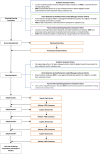Defining terminology and outcome measures for evaluating overdose response technology: An international Delphi study
- PMID: 40277174
- PMCID: PMC12228023
- DOI: 10.1111/dar.14055
Defining terminology and outcome measures for evaluating overdose response technology: An international Delphi study
Erratum in
-
Correction to "Defining Terminology and Outcome Measures for Evaluating Overdose Response Technology: An International Delphi Study".Drug Alcohol Rev. 2025 Sep;44(6):1822. doi: 10.1111/dar.70020. Epub 2025 Aug 18. Drug Alcohol Rev. 2025. PMID: 40820552 No abstract available.
Abstract
Introduction: Various novel harm reduction services leverage technology to reduce the rising number of drug poisoning deaths, particularly among those who use drugs alone. There is significant variability in terminology and outcome measures in reporting these interventions, complicating efforts to build a comprehensive knowledge base. Thus, we conducted a Delphi study to establish consensus and heterogeneity in these metrics.
Methods: Panellists from three stakeholder groups (people who use drugs, virtual harm reduction service operators and academics) participated in a multi-round Delphi study. The first round included open-ended questions to propose items in three categories: terminology, demographic information and outcomes. Subsequent rounds included options from a previously conducted scoping review for consideration. Likert ratings were used to achieve consensus, with a 70% threshold. Final rounds involved ranking terminology that reached a consensus.
Results: Of 23 initial participants, 14 completed the fourth survey round. "Overdose response technology" was identified as the most appropriate term for these harm reduction technologies. This definition includes drug contamination alerts, overdose response hotlines and applications, wearable overdose detection technology and overdose detection tools. Fourteen demographic outcomes reached a consensus for data collection, including name or handle, neighbourhood, age, gender, past overdose experience, substance used, amount and route of use. Six service use outcomes were recommended: response type, service outcomes, morbidity and mortality, overdose events, responder arrival time and post-rescue care.
Discussion and conclusions: The study results are recommended to standardise terminology and guide future research and knowledge dissemination in the field, ensuring clear communication with a shared language.
Keywords: Ehealth; mobile overdose response services; overdose detection technologies; virtual harm reduction; virtual supervised consumption.
© 2025 The Author(s). Drug and Alcohol Review published by John Wiley & Sons Australia, Ltd on behalf of Australasian Professional Society on Alcohol and other Drugs.
Conflict of interest statement
M. G. is a co‐founder and advisor for the National Overdose Response Service (NORS), receives funding from Health Canada's Substance Use and Addiction Program and is a board member of the Canadian Society of Addiction Medicine. D. V. receives salary funding through the University of Calgary via Health Canada's Substance Use and Addiction Program, which provides operational funding for NORS. S. C. receives funding from the National Institutes of Health/National Institute on Drug Abuse, National Institute on Biomedical Imaging and Bioengineering and Indivior, PLC. O. K. is a co‐founder of Brave Technology Co‐op and a co‐founder of NORS. Brave Tech Co‐op has received funding from HC SUAP for technical assistance in implementing NORS. J. C. is the Chief Executive Officer of Naxos Neighbours. M. B. is a co‐founder of Never Use Alone. All other authors declare no conflicts of interest.
Figures



References
-
- World Health Organization . Opioid overdose [Internet] [cited 25 October 2023]. Available from https://www.who.int/news-room/fact-sheets/detail/opioid-overdose
MeSH terms
Grants and funding
LinkOut - more resources
Full Text Sources
Miscellaneous

